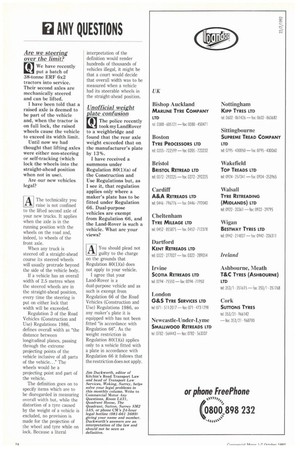El ANY QUESTIONS
Page 26

If you've noticed an error in this article please click here to report it so we can fix it.
Are we steering over the limit?
We have recently put a batch of 38-tonne ERF 6x2 tractors into service. Their second axles are mechanically steered and can be lifted.
I have been told that a raised axle is deemed to be part of the vehicle and, when the tractor is on full lock, the raised wheels cause the vehicle to exceed its width limit.
Until now we had thought that lifting axles were either non-steering or self-tracking (which lock the wheels into the straight-ahead position when not in use).
Are our new vehicles legal?
A The technicality you raise is not confined to the lifted second axle of your new trucks. It applies when the axle is in the running position with the wheels on the road and, indeed, to wheels of the front axle.
When any truck is steered off a straight-ahead course its steered wheels will usually protrude beyond the side of the vehicle body.
If a vehicle has an overall width of 2.5 metres when the steered wheels are in the straight-ahead position, every time the steering is put on either lock that width will be exceeded.
Regulation 3 of the Road Vehicles (Construction and Use) Regulations 1986, defines overall width as "the distance between longitudinal planes, passing through the extreme projecting points of the vehicle inclusive of all parts of the vehicle..." The wheels would be a projecting point and part of the vehicle.
The definition goes on to specify items which are to be disregarded in measuring overall width but, while the distortion of a tyre caused by the weight of a vehicle is excluded, no provision is made for the projection of the wheel and tyre while on lock. Because a literal
interpretation of the definition would render hundreds of thousands of vehicles illegal, it might be that a court would decide that overall width was to be measured when a vehicle had its steerable wheels in the straight-ahead position.
















































































